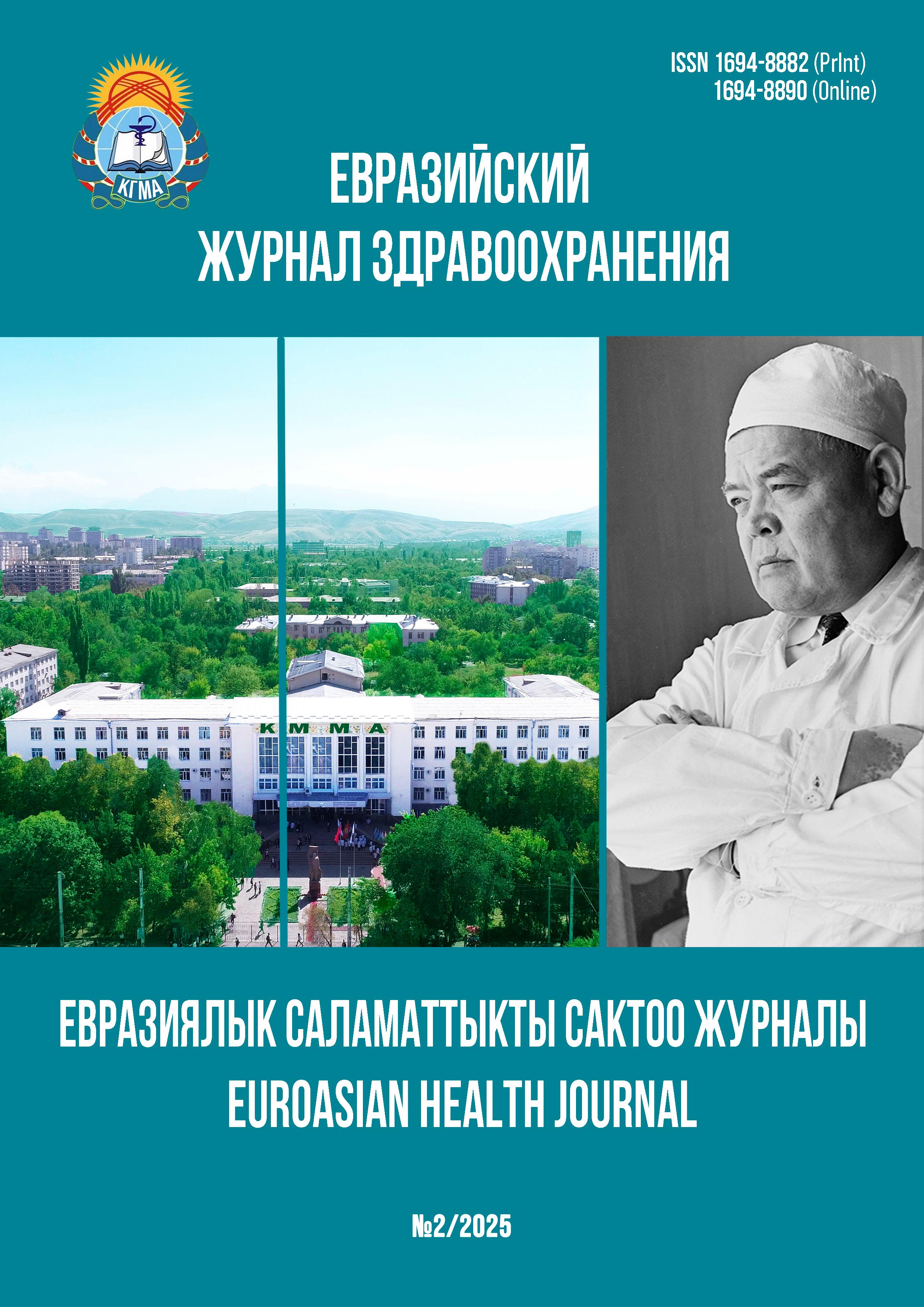АНАЛИЗ РАСПРОСТРАНЕННОСТИ И КЛИНИЧЕСКОГО ТЕЧЕНИЯ ПЕРЕЛОМОВ ОКОЛОНОСОВЫХ ПАЗУХ
DOI:
https://doi.org/10.54890/1694-8882-2025-2-136Аннотация
Актуальность исследуемой проблемы обусловлена недостаточностью информации о распространенности и клинического течения переломов придаточных пазух носа в г. Астана. Задачей текущего исследования является выявление распространенности и эпидемиологических особенностей переломов придаточных пазух носа в городе Астана. Цель исследования: провести ретроспективный анализ указанных травм в городе Астана. Изначально исследование вошли истории болезней пациентов за период с 2018 года по 2023 год обоих полов в возрасте от 8 до 84 лет (всего 314 человек), у которых был диагностирован перелом придаточных пазух. Из 314 случаев 293 соответствовали критериям включения и исключения. Медицинские записи этих 293 случаев (включая истории болезни и записи клинических осмотров, медицинские изображения, такие как рентгеновские снимки и компьютерная томография, а также их отчеты) были тщательно изучены. Мужчины в возрасте 13-35 лет были наиболее часто поражаемыми, а дорожно-транспортное происшествие и мотоциклетная авария были наиболее распространенной причиной переломов. Приблизительно половина пациентов (n = 160, 54,6%) получило хирургическое лечение. Открытая репозиция и внутренняя фиксация были выполнены 87 пациентам (29,7%). У 11% пациентов лечение отсутствовало. Наиболее частым осложнением было инфицирование послеоперационной раны или ткани около металлической конструкции. Представленные данные имеют потенциальное значение для разработки новых стратегий профилактики травм и выявления пациентов с риском развития послеоперационных осложнений.
Ключевые слова:
заболевания пазух носа; эпидемиология переломов; здоровье населения; челюстно-лицевая хирургия; КазахстанБиблиографические ссылки
1. Karim N, Mumporeze L, Nsengimana V, Gray A, Kearney A, Aluisio AR, et al. Epidemiology of Patients with Head Injury at a Tertiary Hospital in Rwanda. The Western Journal of Emergency Medicine. 2021;22(6):1374-1378. https://doi.org/10.5811/westjem.2021.4.50961
2. Jaber MA, AlQahtani F, Bishawi K, Kuriadom ST. Patterns of Maxillofacial Injuries in the Middle East and North Africa: A Systematic Review. Int Dent J.2021;71(4):292-299. https://doi.org/10.1111/idj.12587
3. Reddy CL, Patterson RH, Wasserman I, Meara JG, Afshar S. Oral and Maxillofacial Surgery: An Opportunity to Improve Surgical Care and Advance Sustainable Development Globally. Oral and Maxillofacial Surgery Clinics of North America. 2020;32(3):339-354. https://doi.org/10.1016/j.coms.2020.03.001
4. Kostakis G, Stathopoulos P, Dais P, Gkinis G, Igoumenakis D, Mezitis M, et al. An epidemiologic analysis of 1,142 maxillofacial fractures and concomitant injuries. Oral Surgery, Oral Medicine, Oral Pathology and Oral Radiology. 2012;114(5 Suppl):69-73. https://doi.org/10.1016/j.tripleo.2011.08.029
5. Chalya PL, Mchembe M, Mabula JB, Kanumba ES, Gilyoma JM. Etiological spectrum, injury characteristics and treatment outcome of maxillofacial injuries in a Tanzanian teaching hospital. Journal of Trauma Management & Outcomes. 2011;5:7. https://doi.org/10.1186/1752-2897-5-7
6. Blatt S, Rahimi-Nedjat R, Sagheb K, Piechowiak L, Walter C, Brüllmann D. Coincidence of mandibular fractures with isolated posterior maxillary sinus fractures. Dental Traumatology: Official Publication of International Association for Dental Traumatology. 2017;33(5):345-349. https://doi.org/10.1111/edt.12345
7. Abosadegh MM, Saddki N, Al-Tayar B, Rahman SA. Epidemiology of Maxillofacial Fractures at a Teaching Hospital in Malaysia: A Retrospective Study. Biomed Res Int. 2019;2019:9024763. Published 2019 Feb 13. https://doi.org/10.1155/ 2019/9024763
8. Telfer MR, Jones GM, Shepherd JP. Trends in the aetiology of maxillofacial fractures in the United Kingdom (1977-1987). The British Journal of Oral & Maxillofacial Surgery. 1991;29(4):250-255. https://doi.org/10.1016/0266-4356(91)90192-8
9. Wusiman P, Maimaitituerxun B, Guli Saimaiti A, Moming A. Epidemiology and Pattern of Oral and Maxillofacial Trauma. Journal of Craniofacial Surgery, Publish Ahead of Print. 2020;31(5):e517-e520. https://doi.org/10.1097/SCS.0000 000000006719
10. Chekijian S, Paul M, Kohl VP, Walker DM, Tomassoni AJ, Cone DC et al. The global burden of road injury: its relevance to the emergency physician. Emergency Medicine International. 2014:2014(1);139219. https://doi.org/10.1155/2014/139219
11. Giummarra MJ, Beck B, Gabbe BJ. Classification of road traffic injury collision characteristics using text mining analysis: Implications for road injury prevention. PLoS One. 2021;16(1):e0245636. Published 2021 Jan 27. https://doi.org/ 10.1371/journal.pone.0245636
12. Pawar SS, Rhee JS. Frontal Sinus and Naso-orbital-Ethmoid Fractures. JAMA Facial Plastic Surgery. 2014;16(4):284-289. https://doi.org/10.1001/jamafacial.2014.14
13. Cantini Ardila JE, Mendoza MÁ, Ortega VG. Sphenoid sinus and sphenoid bone fractures in patients with craniomaxillofacial trauma. Craniomaxillofac Trauma Reconstr. 2013;6(3):179-186. doi:10.1055/s-0033-1343778
14. Craig J, Goyal P. Patterns and sequelae of sphenoid sinus fractures. Am J Rhinol Allergy. 2015;29(3):211-214. https://doi.org/10.2500/ajra.2015.29.4160
15. Cabalag MS, Wasiak J, Andrew NE, Tang J, Kirby JC, Morgan DJ. Epidemiology and management of maxillofacial fractures in an Australian trauma centre. Journal of Plastic, Reconstructive & Aesthetic Surgery. 2014;67(2):183-189. https://doi.org/10.1016/j.bjps.2013.10.022
16. Yang L, Xu M, Jin X, et al. Complications of absorbable fixation in maxillofacial surgery: a meta-analysis. PLoS One. 2013;8(6):e67449. Published 2013 Jun 28. https://doi.org/10.1371/journal.pone.0067449
17. Lone PA, Wani NA, Ain QU, Heer A, Devi R, Mahajan S. Common postoperative complications after general anesthesia in oral and maxillofacial surgery. National Journal of Maxillofacial Surgery. 2021;12(2):206-210. https://doi.org/10.4103/ njms.NJMS_66_20
18. Hirobe Y, Koshinuma S, Nakamura M, Baba M, Yamamoto G, Hitosugi M. Factors influencing the long-term hospitalization of bicyclists and motorcyclists with oral and maxillofacial injuries. Dent Traumatol. 2021;37(2):234-239. https://doi.org/10.1111/edt.12622
19. Echlin P, McKeag DB. Maxillofacial injuries in sport. Curr Sports Med Rep. 2004;3(1):25-32. https://doi.org/10.1249/00149619-200402000-00006
20. Yerdessov N, Izdenov A, Beisenov T, Suleimenova R, Serik B, Sraubaev E. Industrial traumatism and occupational morbidity in mining industry of Kazakhstan. Journal of Public Health Research. 2021;11(1):2169. https://doi.org/10.4081 /jphr.2021.2169
21. Liu G, Ou S, Cui H, Li X, Yin Z, Gu D, et al. Head Injury and Amyotrophic Lateral Sclerosis: A Meta-Analysis. Neuroepidemiology. 2021;55:11-19. https://doi.org/ 10.1159/000510987
22. Liu HH, Li LJ, Shi B, Xu CW, Luo E. Robotic surgical systems in maxillofacial surgery: a review. International Journal of Oral Science. 2017;9(2):63-73. https://doi.org/10.1038/ijos.2017.24
23. Alpert HR, Slater ME, Yoon YH, Chen CM, Winstanley N, Esser MB. Alcohol Consumption and 15 Causes of Fatal Injuries: A Systematic Review and Meta-Analysis. Am J Prev Med. 2022;63(2):286-300. https://doi.org/10.1016/ j.amepre.2022.03.025







